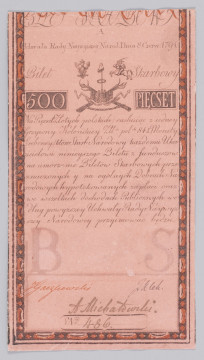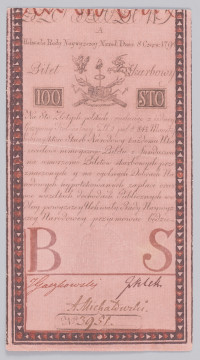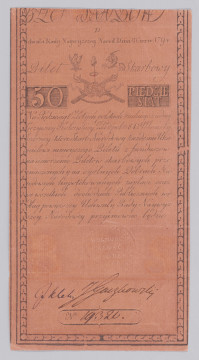
Treasury ticket - 500 Polish zlotys
1794
National Museum in Lublin
Part of the collection: Paper money of the Kościuszko Uprising and the Duchy of Warsaw
Until 1794, the Polish financial system was based solely on bullion coinage. On 24 March 1794, with the proclamation of the Act of Uprising, among many other decisions, the existing monetary system of the Republic was changed. As a result, talars (equivalent to 6 zlotys, and not 8 zlotys as before), 2-zlotys, 1-zloty, 10-groszy and 6-groszy coins, as well as coins in the form of ‘trojaks’ and groszy were to be circulated. Very soon it turned out that a shortage of bullion significantly limited the issuing capabilities of the insurgent authorities, and the conduct of military operations required an influx of large amounts of money. In that situation, the authorities of the uprising reached for a means which had not been used in Poland before. It was the emission of paper money. On 8 April 1794, the National Supreme Council, which was the executive body of the uprising's leader, set up the Directorate of Treasury Bills. It was the first institution in Poland to issue paper money. The treasury tickets it issued were not money in the full meaning of the word. They were rather a temporary substitute for money. After the uprising was over, they were to be redeemed for bullion money. In August 1794, tickets in the denominations of 5, 10, 25, 50, 100, 500 and 1000 zlotys were put into circulation, but the lack of bullion money also affected the lower denominations. As a result, tickets with the face value of 4 zlotys appeared in September, 5 and 10 groszy in October, and 1 zloty on 1 November, that is six days before the fall of the Uprising.
Treasury tickets with the face value of 10 groszy were printed in the amount of 377,028 pieces, which corresponded to 125,676 zlotys at that time. They were put into circulation on 20 October 1794, although the inscription on the obverse referred to the resolution of 15 August 1794. As in the case of the 5 groszy tickets, the obverse and reverse were printed on separate sheets, and then cut out and glued together. Protection against forgery was provided by the overprint in the form of the letter ‘X’, applied on the reverse with the help of a special paint which, dissolving slightly, permeated also the obverse side. Both haste and technical difficulties sometimes led to minor mistakes, such as turning the facsimile of the signature ‘F. Malinowski’ on the reverse by 180o or a misalignment when gluing the obverse and reverse together.
Leszek Poniewozik
Author / creator
Dimensions
cały obiekt: height: 67 mm, width: 52 mm
Object type
paper money
Technique
woodcut
Creation time / dating
Creation / finding place
Owner
The National Museum in Lublin
Identification number
Location / status

1794
National Museum in Lublin

1794
National Museum in Lublin

1794
National Museum in Lublin
DISCOVER this TOPIC
National Museum in Szczecin
DISCOVER this PATH
Educational path